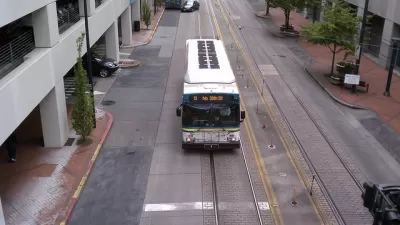A new report details the trend of jobs densification in U.S. metropolitan areas between 2004 and 2015, finding a few large metropolitan areas leading an overall increase in jobs density. Still, many areas are seeing jobs disperse around the region.

Chad Shearer, Jennifer S. Vey, and Joanne Kim share their findings from a new report on the trends in jobs density in U.S. metropolitan areas.
This report aims to help leaders and local stakeholders understand how the changing demands for place are shifting the concentration and dispersal of economic activity within 94 large metropolitan areas from 2004 to 2015—a period of dramatic urban and economic change.
The findings suggest a need for local leaders to embrace policies and investment strategies that advance more concentrated growth patterns, while also supporting transformative placemaking solutions that help such dense places become vibrant communities where businesses and workers thrive.
The article that shares the report includes a series of interactive graphics to illustrate the findings of the report. The key findings: U.S. metropolitan areas are experiencing a higher-than-expected rate of densification of job growth. Densification favored already-dense counties inside these metropolitan areas, and densification for the country was driven by four areas: New York, Chicago, San Francisco, and Seattle. "In fact, these four metro areas accounted for about 90% of the increase in job density seen among all 94 large metro areas during this period," according to the graphic. "In contrast, overall job density in the other 90 large metro areas increased only 9%."
Other interactive graphics break down the trends by industry sector and specific metropolitan areas. Trends varied dramatically between specific metropolitan areas. "Out of the 94 large metro areas in our study, only 48 posted an increase in job density from 2004 to 2015," according to the infographic. Job density declined in 46 metropolitan areas, like Sacramento, California; Cape Coral, Florida; Scranton, Pennsylvania; Youngstown, Ohio-Pennsylvania; and New Haven, Connecticut.
FULL STORY: Where jobs are concentrating and why it matters to cities and regions

Planetizen Federal Action Tracker
A weekly monitor of how Trump’s orders and actions are impacting planners and planning in America.

San Francisco's School District Spent $105M To Build Affordable Housing for Teachers — And That's Just the Beginning
SFUSD joins a growing list of school districts using their land holdings to address housing affordability challenges faced by their own employees.

The Tiny, Adorable $7,000 Car Turning Japan Onto EVs
The single seat Mibot charges from a regular plug as quickly as an iPad, and is about half the price of an average EV.

Seattle's Plan for Adopting Driverless Cars
Equity, safety, accessibility and affordability are front of mind as the city prepares for robotaxis and other autonomous vehicles.

As Trump Phases Out FEMA, Is It Time to Flee the Floodplains?
With less federal funding available for disaster relief efforts, the need to relocate at-risk communities is more urgent than ever.

With Protected Lanes, 460% More People Commute by Bike
For those needing more ammo, more data proving what we already knew is here.
Urban Design for Planners 1: Software Tools
This six-course series explores essential urban design concepts using open source software and equips planners with the tools they need to participate fully in the urban design process.
Planning for Universal Design
Learn the tools for implementing Universal Design in planning regulations.
Smith Gee Studio
City of Charlotte
City of Camden Redevelopment Agency
City of Astoria
Transportation Research & Education Center (TREC) at Portland State University
US High Speed Rail Association
City of Camden Redevelopment Agency
Municipality of Princeton (NJ)





























